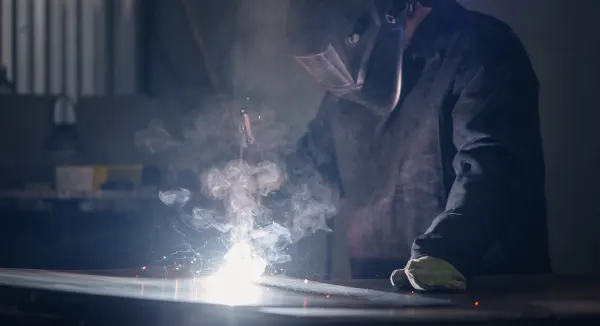Speak to an Air Purification Expert
Speak to an Air Purification Expert
HEPA Filtration for Welding Fume: Why Bother?
November 4th, 2024 | Posted in Welding

We have long known that prolonged over exposures to welding fume places welders at increased risk for respiratory system ailments, particularly lung cancer[i]. Hexavalent chromium (Cr(VI)) and nickel compound exposures have long been identified as lung carcinogens and have therefore been regarded as the primary contaminants of concern. Promulgation of the OSHA Hexavalent Chromium Standard (29 CFR 1910.1026) has consequently resulted in the focus being primarily on Cr (VI) exposures during stainless steel welding. It should be noted that other metals also contain enough chromium to result in hexavalent chromium over exposures. These include:
- E 8018 SMAW electrodes
- 1¼ Chrome (4130 or chrome moly steel)
- Inconel
- Hastalloy
- Stellite Alloys
- Recycled Carbon steel/Mild steel
- Commonly welded aluminum alloys
However, in addition to concerns regarding hexavalent chromium and nickel, the Occupational Safety and Health community now faces a new challenge regarding welding fume: The International Association for Research on Cancer (IARC) has classified “welding fume” as Group 1 carcinogen [ii] with the lung as the target organ. In Monograph 188, IARC estimated that 121 million people are likely exposed to welding fume as part of their work. Although there are substantial differences in the makeup of fumes produced by differing combinations of metals and welding processes, this IARC classification does not differentiate among welding fumes and addresses all welding fume, whether from stainless steel or mild steel or any other metal alloy, as a human carcinogen. Work published by Ambrose, Wild and Moulin (2006) includes an analysis of 60 studies focusing on welder lung risk[iii]. Their two primary findings are:
- Welders are at 26% greater risk for lung cancer than the rest of the non-welder population.
- Mild steel welders are at about the same level of risk for lung cancer as stainless steel welders.

The question arises: What level of filtration should we use when using LEV to control welding fume? To answer the question, Air Quality Engineering, Inc. performed testing of an M66V portable air cleaner during SMAW (“stick”) welding stainless steel under two conditions:
- With a 95% ASHRAE filter but without a HEPA post filter
- With a 95% ASHRAE filter backed up with a HEPA post filter
For comparison, a run was also conducted with no LEV.
Cr(VI) fume concentrations during SMAW welding stainless steel
(n= number of samples)
| Sample location | NO LEV | No HEPA | With HEPA |
| Inside welder’s helmet | 658 ug/m3.
n=1 |
17 ug/m3.
n=3 |
4 ug/m3.
n=3 |
| Area samples | 28 ug/m3.
n=3 |
6 ug/m3.
n=9 |
1 ug/m3.
n=9 |
Take-Aways:
- Inside the welder’s helmet:
- the fume concentrations WITH HEPA are only 24% of the concentrations WITHOUT HEPA;
- A four-fold improvement in fume control.
- Area samples:
- fume concentrations WITH HEPA are only 17% of the concentrations WITHOUT HEPA;
- A six-fold improvement in fume control.
These data indicate that HEPA provides a substantial improvement in worker protection when compared to a non-HEPA filtration system. Since we are dealing with a carcinogen, the improvement is certainly worthwhile. Your Air Quality Engineering application specialist can work with you to specify an LEV system configured to meet your needs. Until effective LEV is in place, it is best practice to protect welders with respiratory protection in accordance with the OSHA Respiratory Protection Standard 29 CFR 1910.134.
[i] Hansen, K.S., J.M. Lauritsen, and A. Skytthe: Cancer incidence among mild steel and stainless steel welders and other metal workers. Am. J. Ind. Med. 30, 373–382 (1996).
[ii] International Association for Research on Cancer, World Health Organization: Welding, Molybdenum Trioxide, and Indium Tin Oxide, Volume 118, Lyon France 2018, pg. 33.
[iii] Ambrose D., P. Wild, and J.-J. Moulin: Update of a meta-analysis on lung cancer and welding. Scand J Work Environ Health. 32(1):22-31 (2006).
[iv] Falcone LM, A. Erdely, V. Kodali, et. al “Inhalation of iron-abundant gas metal arc welding-mild steel fume promotes lung tumors in mice” Toxicology 409: 24-32. (2018).

